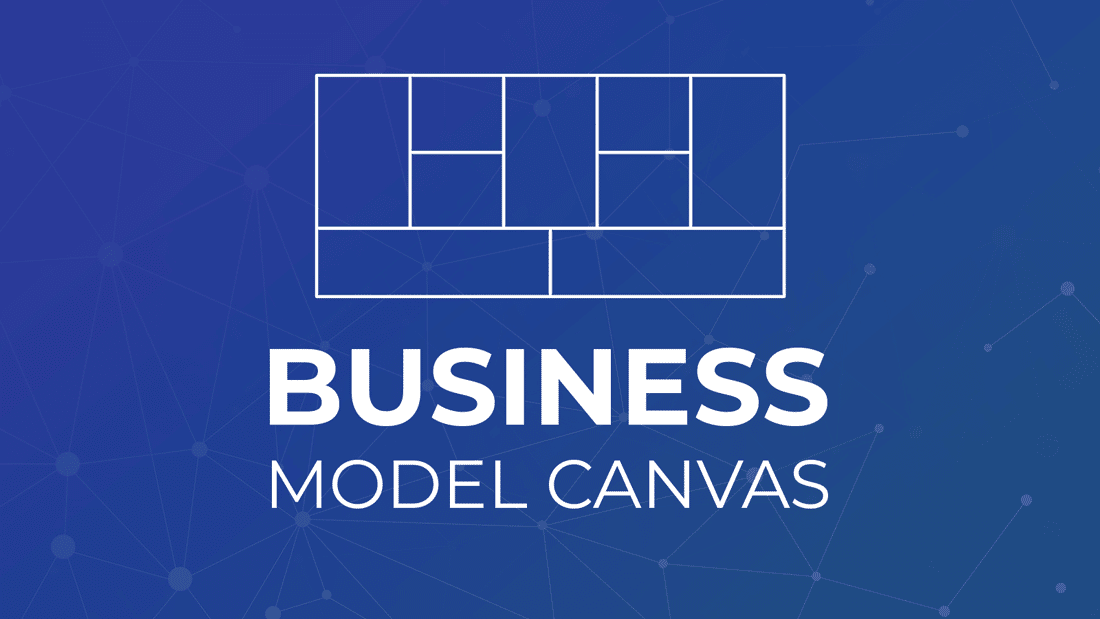Based on the work of Alexander Osterwalder, the Business Model Canvas, or BMC for short, is a diagram used to visualize a business model; it allows structured organization and a quick method of evaluation and reflection on the effectiveness of the Business Model. The business model canvas is a graphical representation of an enterprise model that highlights all key strategic elements. In other words, it is a general, comprehensive, and thorough overview of the company’s operations, customers, revenue streams, and so on.
The Role of the Business Model Canvas
Whether it be in small business entrepreneurship, large corporate product launches, business plan, or business pivots, the business model canvas sits at the center. The one thing that stands at the very heart of the daily operations of an organization, is a model that dictates where the opportunities lie and how the company effectively acts on them at each step in the process.
The very best professionals will have and understand all of this strategy and knowledge and action driving their decisions to become better and subject to any development. However, the original enterprise model one may follow may not always apply to the obstacles that an organization faces, thus it’s incredibly good and useful to fully display organizational structure and operations and is easily adaptable to new business climates and conditions.
The Basics of the Business Model Canvas
Whether one is creating an all-new enterprise model, comparing a pre-existing model or business plan, benchmarking competition, or adjusting a model to pivot or improve value, the BMC excels in keeping anyone invested in the business on track without wasting time and focus. By displaying only, the most critical pieces in business operations or a product launch, this tool is both a time saver and a method to learn and sharpen your awareness of expectations versus reality.
There are eight foundational sections in a BMC and five strategic sections across the top of the advanced canvas along with two sections at the bottom for MVP testing and environmental testing around the exterior. Each section contains a specified topic of information that composes the core essentials of any enterprise model.
1. Customer Segments
Customer segmentation is the process of grouping customers based on shared characteristics so that businesses can market to each group effectively and appropriately. Customer segments contain the information related to the core target audience that you are marketing towards. Simple and traditional segmentation analysis must be done to identify and learn the top customer segments of the model. Start simple with questions like:
- What are the demographics of the major customer groups being targeted?
- Why are they going to be interested in the product or service?
- What are their current pains or problem that our solution will address and be considered relevant enough for them to pay us for it?
In essence, how well does the model comprehend who is being sold to and why? You must identify the customer segments when facing reality. You will need to focus only on a few (1 or 2) to test your model without a full operation in place.
2. Value Propositions
A value proposition is a value that a company promises to provide to customers if they purchase its product. A value proposition is an important component of a company’s overall marketing strategy. The value proposition is a statement or declaration of intent that introduces a company’s brand to consumers by explaining what the company stands for, how it operates, and why it deserves its business.
Customers choose your company over another because of the business model canvas value proposition. It either solves your customer’s problem or meets your customer’s need. Each Value Proposition is made up of a carefully selected bundle of products and/or services that cater to the needs of a specific Customer Segment. Create a list of the unique business positions and key activities you will offer. Why is the company valuable? What makes it stand above competitors? If there aren’t any direct competitors, what gaps are being filled in given markets?
This section could be extremely lengthy, depending on the enterprise model, but should only contain the most central concepts at the heart of the model that attract customers or generate revenues. If you’re struggling to identify what is most important, consider using a Value Proposition Canvas, another easy-to-visualize tool that helps establish your target audience with your strengths. Focus on solving a real pain for the segments identified.
3. Customer Relationships
Customer relations is the process of cultivating positive relationships with your customers at the company level — the sum of all customer interactions and experiences. The information in this section of the model should refer to how to connect segments and the value proposition. During the analysis, you should be asking questions like:
- How are customers convinced that your product or organization has the advertised special qualities?
- What methods are used to interact with them?
- How does an audience engage with each strategy in the product lifestyle?
- How is customer engagement tracked?
4. Channels
Channels are an essential component of the business model. They are how a company communicates with and reaches out to its customer segments. Channels can be direct or indirect, with five stages: awareness, evaluation, purchase, delivery, and after-sales. It is recommended to ask the following:
- Once the customer is convinced of the goods or services, how would you deliver them?
- Is there a separate supplier?
- Who distributes the product?
- How is it displayed?
This should include every step of the process it takes to make the financial transaction possible. Think about what the model requires from start to finish to make a sale.
5. Revenue Streams
The various sources from which a business earns money from the sale of goods or the provision of services are referred to as revenue streams. The types of revenue that a company records on its books are determined by the activities that the company performs. If the customer connects with the product or service, and they want to proceed with doing business, then how does the actual exchange of money happen? How is the cash flow tracked? Are there any middlemen between the sale and the income to the business?
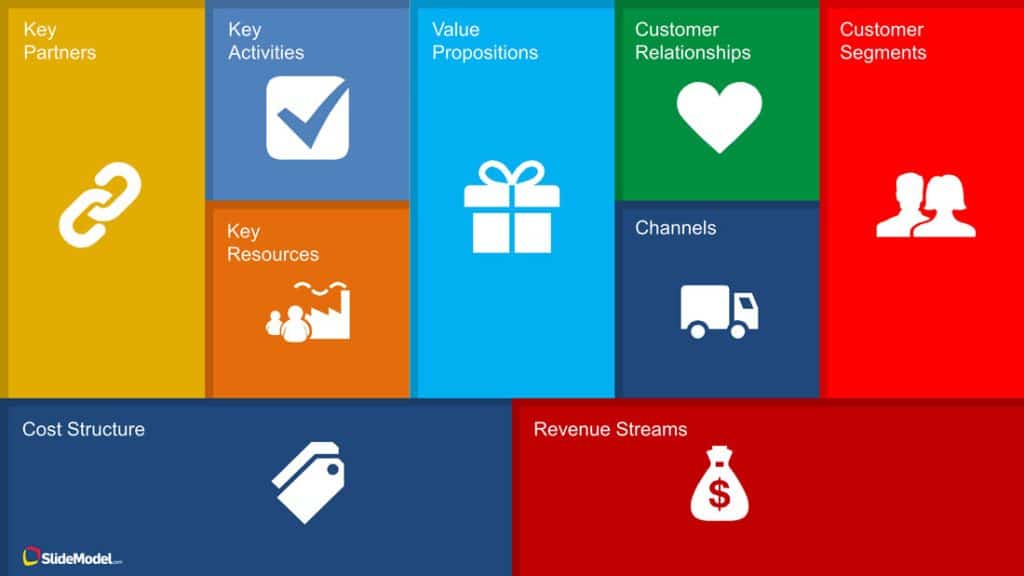
6. Key Activities
This section should include specific activities that the organization will do that will make it stand out from the rest. Unlike the Value Propositions, it’s not just about a new product or business practice, but rather the day-to-day operations that each team will take to stay a step ahead of the competition.
A number of Key Activities are required by your business model. These are the most important actions that your company must take in order to be successful. They, like Key Resources, must create and offer a Value Proposition, reach markets, maintain Customer Relationships, and generate revenue. Key Activities, like Key Resources, vary depending on the type of business model.
7. Key Resources and Partnerships
Similar to Key Activities but focusing on assets that can be used to gain an edge instead. Is there a special supplier? Is there access to any materials or a local storefront that puts you in an advantageous position? Do you have a special intellectual property or patent that introduces new knowledge into the niche?
For areas that may be lacking, or areas that are too costly for the business to manage by itself, what can be outsourced to partners to focus on? Which areas would it be more cost-efficient to hire from supporting businesses? Specifically, identify model strengths maximize time and money on them, and move identified weaknesses to connected partners that can address them better or solve them all together. The relationships you have with other businesses, governments, or non-consumer entities that help your business model work are referred to as key partners. These can be your company’s relationships with its suppliers, manufacturers, business partners, and so on.
8. Cost Structure
The cost structure of the Business Model Canvas describes the costs that a business incurs as a result of its operations. Employees, infrastructure, costs associated with all activities, and sourcing through key partnerships are among them.
Finally, what are the major expenses in the model? Are they a flat fee, or are they a variable cost? This may factor into previous sections, like key activities, resources, and partnerships. Additionally, how does this relate to the Revenue Streams? How will the predicted costs vs. the actual be monitored? Most importantly, what will be done if costs outweigh the incoming funds? Creating the Business Model Canvas involves analyzing each of these sections individually and as a whole, and connecting the dots between them.
The Power of a BMC in Entrepreneurship: Visualize the Business Model
Introducing a new business, executing a pivot, or launching a new product to the world is no small undertaking, especially when you consider how much competition and other new ideas are thrown into the world on an annual basis. The difference between being one of the many ideas that fall flat and the cream that floats to the top is understanding the enterprise model, in and out.
This also means keeping the model current and responsive. An enterprise model, after all, is only a well-educated guess on how to generate success from a demand. If reality does not match up to the prediction, then even the very best business models are useless. A BMC is your abstract representation and the reminder of what truly matters each day.
Steven Blank’s article to entrepreneurs and business leaders, “Four Steps to the Epiphany”, demonstrates the difference between those who watch and listen to their model in action, and those who convince themselves that their company model is flawless, and the world will adjust to follow it instead. The fact is, you may have the most amazing ideas in the world, but it won’t matter if you aren’t paying attention to unforeseen challenges that arise between the conception and actualization of a successful model.
The BMC is an excellent tool to get away from the guesswork, and out into the metaphorical streets. It allows an individual or team to compare expectations with reality, to double-check targets and see if those targets are still manageable, and it allows making adjustments to an enterprise model before it’s too late.
This practice is called, “Get out of the building”. It means to develop a BMC and test it against reality. For this to work, you need to create an MVP (Minimum Viable Product) that materializes your Value proposition and tests it against real-life customers. Testing means that they should purchase the MVP and that they complete the different sections of the BMC for true validation. This process is iterative, and it helps entrepreneurs and business executives to make the adjustments necessary to market a value proposition, reducing the risk of mounting a full-scale operation.
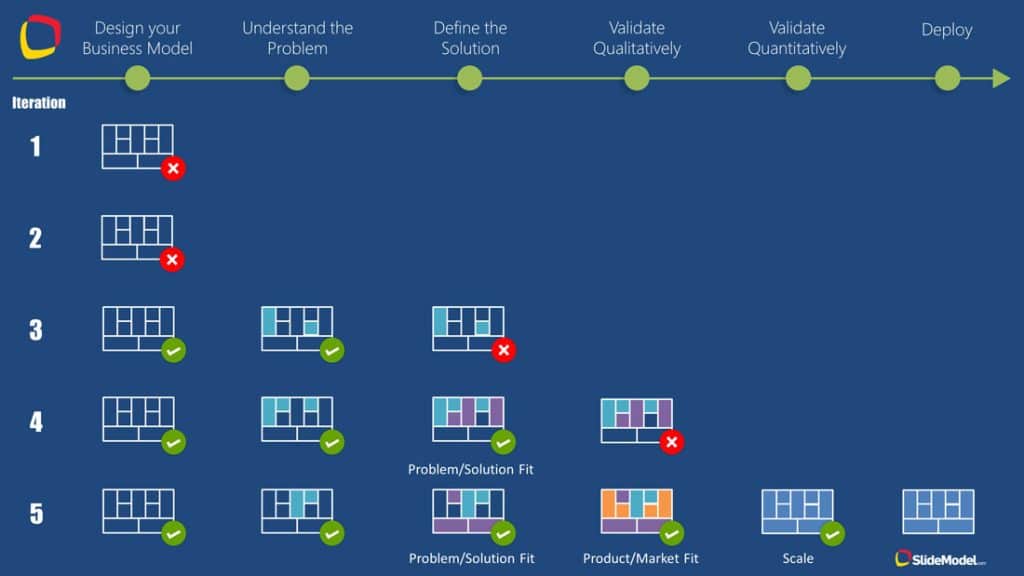
Applying BMCs to Real-World Examples
By using BMCs, we can evaluate enterprise models and identify just what changes need to be made to the model to ensure growth and success. Let’s look at the company MoviePass, for example, which launched with the idea to sell a monthly service to the general public for daily movie tickets at major theater chains for a flat monthly membership fee. The company reasoned that they could benefit two groups, the average moviegoer would be able to see more movies, and movie theaters themselves would see better attendance.
In theory, it sounds like a reasonable concept, but in reality, MoviePass had not developed a functional enterprise model which thrived in a poor performance against new technologies. There was no constant evaluation to keep track of their cash flow, and how by failing to keep the company growing fast enough, it couldn’t support the necessary costs. Perhaps if leadership had followed a BMC these issues may have been recognized earlier and Moviepass could have pivoted.
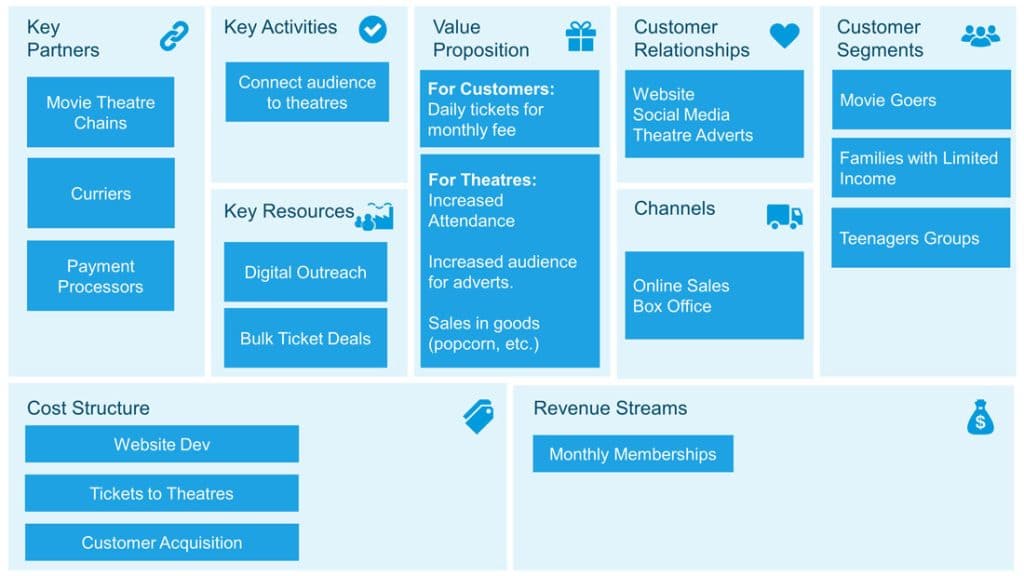
By using the BMC, MoviePass could have visualized earlier that the enterprise model needed a pivot, a change to a section of the model to address an issue. In MoviePass’s case, areas like cash flow and customer acquisition had some gaps that required a solution. Had the company been more aware of its enterprise model, it might have seen a need for a Minimum Viable Product (MVP) where they could test the results of their ideas with a few early adopters.
An MVP is the bare bones of a product or service that can provide invaluable information about how a small group of customers reacts. By having a testing period of limited engagement, a business can limit cost while drastically improving knowledge on how to proceed. Had MoviePass used this, they might’ve been able to observe early on that some customers used their service to the max, purchasing a movie ticket per day, far outweighing the profit of their service from the cost of providing it.
The pivot would adjust to their enterprise model, and a new MVP could be created to test the new approach. This new iteration of the business may have changed the original direction of the company. Through each pivot and each new iteration of the model, MoviePass’ BMC would adjust accordingly, allowing an easy method in which to keep track of the major changes without getting overwhelmed by all the details that lay underneath each educated decision. There are, however, examples of well-crafted existing business models that can be observed on a BMC. Let’s take a company that has spread its enterprise model all over the world and has undoubtedly enacted countless pivots and iterations of the enterprise model to evolve, adapt, and thrive over the years: McDonald’s.
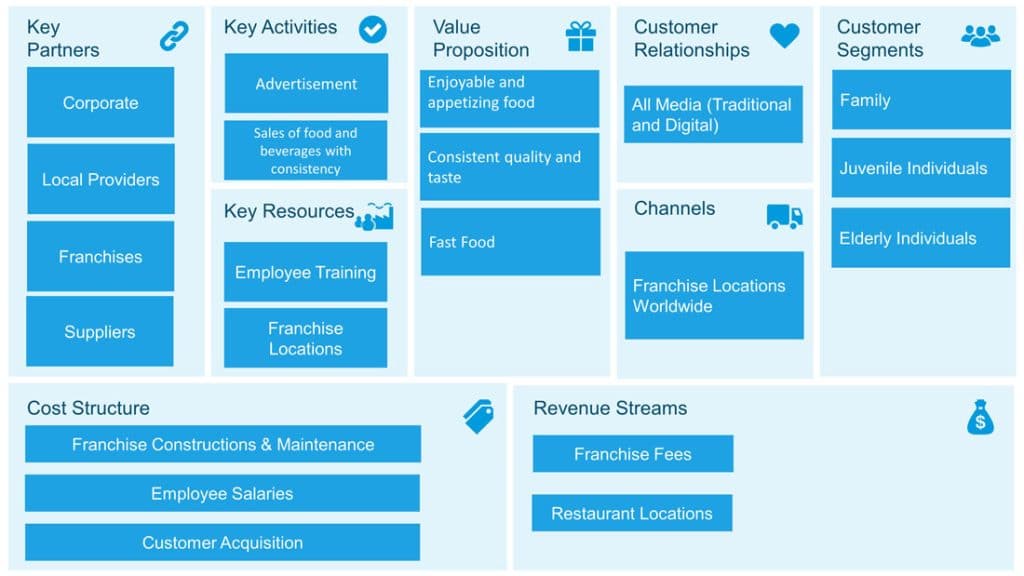
When thinking about the massive scope of McDonald’s, it’s both interesting and telling how the BMC can still capture the essence of its enterprise model. McDonald’s is a global corporate cash cow requiring a rock-solid model, but that doesn’t mean it’s been the same one since the conception of the company.
With the many decades in operation, you can be sure that a McDonald’s BMC would not look the same at the beginning as it does today. What originally started as a single burger joint on a street corner, now faces the challenges of global food service. Each time a new challenge or opportunity presented itself, the McDonald’s enterprise model was forced to pivot by observing the environment, developing an appropriate plan of action, and monitoring the progress accordingly. Over the years the world has grown to experience many iterations of the McDonald’s brand, whether it be an icon of American cuisine or an example of adaptation to dietary health. Flexible and ambitious, McDonald’s always ensured the enterprise model matched desired outcomes.
Utilizing Successful Business Model Canvas Explained
Whether it be a brand-new business endeavor or a product launch at a long-standing company, the enterprise model must be kept at the core of every decision. The Business Model Canvas explained that it keeps the model insight and offers an easy method to open the dialogue when that model may need to pivot. The whole purpose of the BMC is to allow for a simple presentation of information, reducing complications in understanding just what is required in each new iteration of an enterprise model. At a glance, anyone invested in the model’s outcome should be able to understand the model’s who, what, when, where, and why’s of the model, or bring it to everyone’s attention if they don’t.
Most importantly, the BMC is a tool to meet and help drive success among the innovative business model generation. If there are issues in your enterprise model that need to be addressed, a BMC makes it easier to visualize where the gaps are, and how they may be filled. It highlights the key activities to avoid confusion and distraction. Keep in mind that pivoting is crucial to the success and survival of an enterprise model and that change, growth, and adaptation are not an abandonment of what matters, but a natural progression to find the best outcomes to the ultimate goal. As Eric Ries, author of Startup Lessons Learned, puts it: “pivoting may lead successful startups far afield from their original vision and courses, but if you look carefully, you’ll be able to detect common threads that link each iteration.”
Business Model Canvas PowerPoint Templates
This is an excellent tool for understanding an enterprise model in a straightforward, structured manner. Using this canvas will provide insights into the customers you serve, what value propositions are offered through which channels, and how your company generates revenue. You can also use the business model canvas to better understand your own or a competitor’s enterprise model. If you want to create professional-looking Business Model Presentations, take a look at the following canvas template key:
1. Animated 3D Business Model Canvas Template for PowerPoint

Created with a 3D Model, this professional PowerPoint Template is ideal for creating videos or animated versions of the canvas business model. Very popular among educators and speakers of the entrepreneurship niche.
2. Business Model Canvas PowerPoint Templates
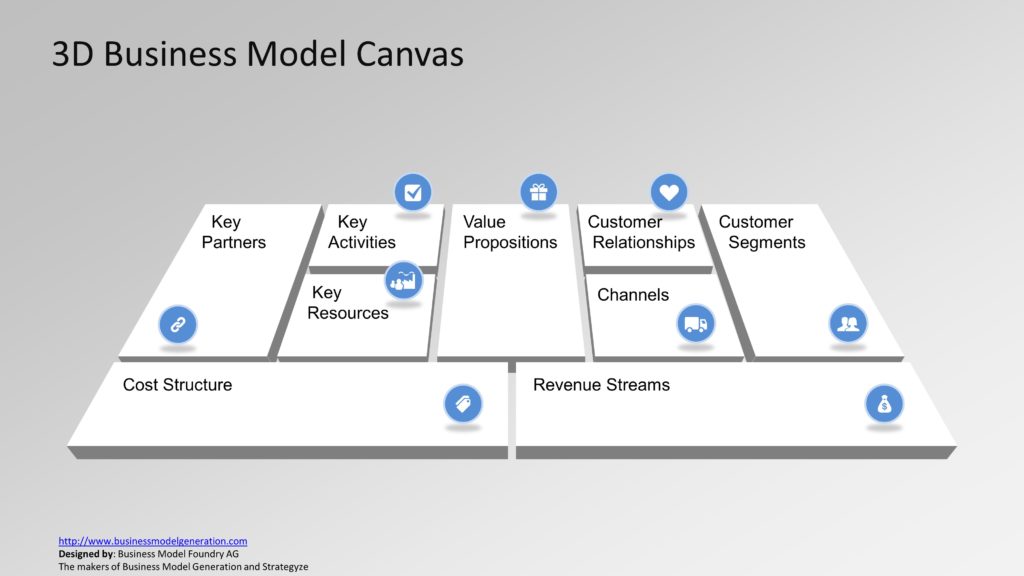
This Canvas PowerPoint Template is created 100% with editable PowerPoint Shapes, allowing the user to customize the content and visual appearance of the presentation. Suitable for educational presentations where you need to navigate each section of the BMC, or for investors’ presentations where you need to deep dive into each section of your enterprise model.
3. Business Model Canvas Template for PowerPoint
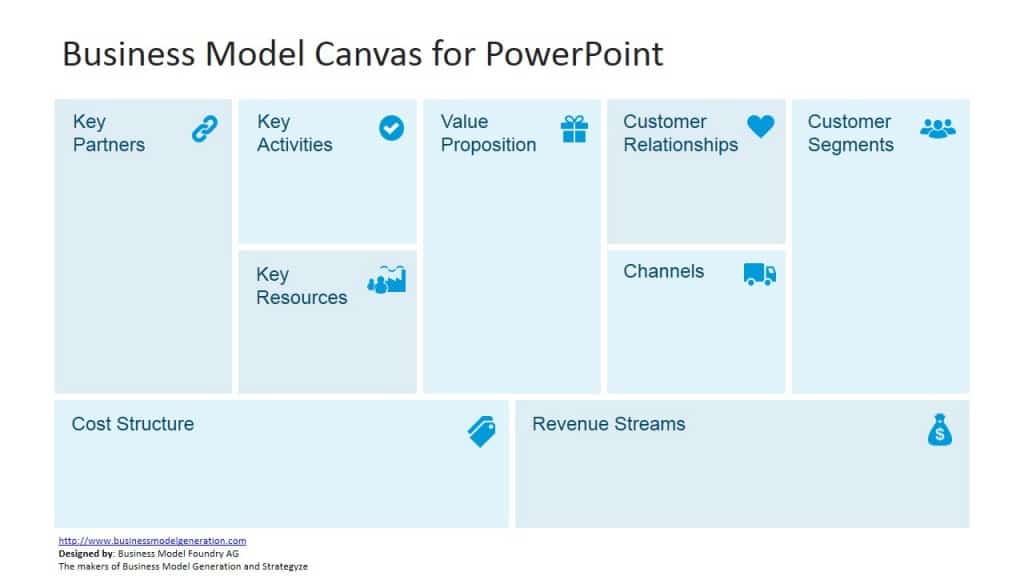
Our most popular Business Model Canvas Template. Ideal for working in groups and iterating with different BMCs. It’s suitable for cooperation editing and allows very simple compositions. Well suited for developing your MVP and crossing the assumptions that were negated by reality.
4. 3D Perspective Business Model Canvas PowerPoint Template
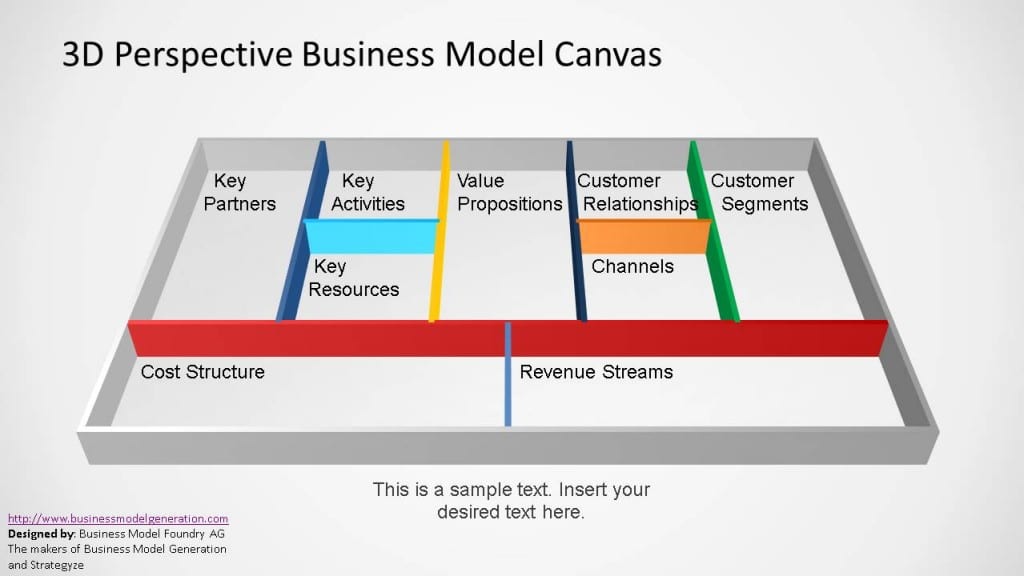
This Business Model Canvas Design is inspired by the idea of empty boxes, that entrepreneurs need to fill with their ideas. The design is simple to edit and decorated with a colorful theme. Designed to impress every audience.
The business model canvas is an amazing tool for understanding a business model in a straightforward and structured manner. Using this canvas would provide perspectives on the customers you serve, what value propositions are offered through which channels, and how your company makes money. A business model, in its most basic form, provides information about an organization’s target market, the needs of that market, and the role that the business’s products or services will play in meeting those needs. The process by which an organization adjusts its business model is described as business model innovation. The business model canvas is a universal language for describing, visualizing, evaluating, and changing business models. It explains why an organization creates, delivers, and captures value.

